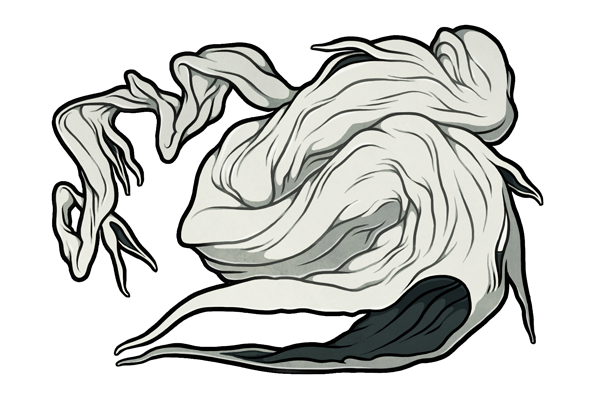

kendride
the stragglers
prefix ken suffix dride
physical appearance
The kendride /ˈkɛndɹaɪd/ is a large, hollow, many-mouthed stranger composed of a thick, tarp-like material, around 0.25 inches thick. Its outer surface is grey and with light mottling or staining, and leaves behind a white, sandy residue when touched. The kendride's vacuous interior is approximately 10°F cooler than external temperatures, while its slick (although not measurably damp) inner surface is a very dark grey. Its eye markings are black with white pupils, and tend to be positioned towards the kendride's underside. It has a strong and earthy odor.
Although the kendride is not unaffected by outside forces, it requires unusual exertion to significantly push or pull, far above what would be expected given the apparent thinness of its skin. It maintains its shape even in windy environments, with only minimal ruffling of its surface. It is also an extremely durable stranger, being heatproof, waterproof, and resistant to cutting and tearing via all but the most high-powered of implements. Despite its sturdiness, the kendride has no regenerative ability, and, when punctured or torn, eventually, collapses and deflates.
The kendride speaks through a hushed whisper that swirls inside its body, its voice a crescendo of individual speakers, some male, some female, audible only from inside its body and never from the outside. It possesses no language of its own, and speaks only through short statements and indecipherable expletives, with the overlapping quality of its voice obfuscating specific phrases.
a rushed cacophony of disparate voices.

environment and generation
The kendride appears by itself in open, outdoor areas surrounded on all sides by a continuous architecture. Courtyards in the center of abandoned schools and government buildings are frequent sites of a kendride infestation. The kendride always appears in the early morning, starting off as a smaller, minimally inflated form which grows in wiggling strains. It takes less than four hours to reach full size, and does not move once matured.
Six percent of kendride generate in atypical locations, and will be found heaped upon a rooftop, caught on power lines, or snagged on tree branches within 655 feet of a courtyard or other open space. These kendride, which survive for less than one day, are far lighter than average in weight, and possess faint inclinations of markings upon their surface. While the kendride is solitary under ideal conditions, these "snagged" kendride tend to appear in small clusters of two to seven individuals.
behaviour and effects
The equable kendride performs no actions, and instead stays in place, its mouths open. It causes no harm to the animals that sometimes seek shelter inside its hollow body during inclement weather.
The kendride's presence appears beneficial to the growth of plant life in its vicinity. Saplings sprout with little difficulty, flowers bloom with greater frequency, and even long-dead plants sometimes show new growth when in close proximity. In addition, most flora has a tendency to grow towards the kendride, including vines and flowers, which normally grow towards the sun.
Despite this beneficial effect, plant matter dies whenever it touches the kendride's body, preventing the kendride itself from becoming overgrown. In addition, plants tend to wither away when transplanted from the kendride's surroundings to a new area, even when great care is taken to ensure their survival.
interactions with sensitives
The kendride's reaction to sensitives is muted, but gregarious. It opens its mouth wider when in proximity of a sensitive, and touched, its surface crinkles and recedes, but returns to full expansion once contact ceases.
Encounters with the kendride incite a need to seek out isolated and overgrown exterior areas. This includes empty lots, open and crumbling houses, or secluded and wooded areas of the city, but does not tend to include parks, unless they are almost unrecognizably wild. There, sensitives discover a quiet and personal enjoyment of these places; they notice the sounds, take in the visual details, and feel a sense of peace and tranquility. Individuals often will take risks and enter dangerous locations, however, feeling a gut instinct that these locations are "tame" and safe to enter. This effect is not necessarily costly: affected individuals do not become distraught if unable to visit these areas. The frequency of these periods of isolations vary; some go every day, some every week, but excursions are rarely less than every two to three weeks.
Oftentimes, the area around a kendride will become the location to which the sensitive returns, although individuals do not tend to pursue continued interaction with the stranger itself.
▖º now ▛▙▚▜¸Ü ▝▞¡C ¥
▘ª¾ ▜▙▚ °µ ¤° »ò ¡?
Ãø ▙▚Å¥ close ▗▗

ɚ
Ҹ
Ҹ
aging and death
When the kendride dies, its body deflates, its inner walls becoming affixed to each other, and its hollow sealing fully in this way. Following its death, the kendride's weight decreases from over 80,000 pounds, to just 768 pounds. Although its corpse remains durable for several days following the kendride's death, it does eventually turn to a sudden, black sludge, which leaves behind a tar-like stain on the ground beneath it.
Without the kendride's presence, the vibrant plants that once surrounded its body grow brittle and wither away. A "kendride summer" is a vibrant but short-lived event, and the deadened area left behind tends to remain barren and lifeless in the years that follow.
Kendride never appear in the same place twice.



